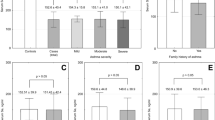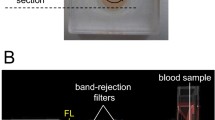Abstract
We evaluated the relationships between neutrophil-related functions and serum selenium (Se) concentration in the general population. We examined 800 subjects who had participated in the Iwaki Health Promotion Project in 2005 to determine the relationships between serum Se concentration and neutrophil-related functions such as the production capability of reactive oxygen species (ROS), phagocytic activity, and serum opsonic activity (SOA). In nonstimulated neutrophils, i.e., in neutrophils at their baseline condition before the application of the phagocytic stimulus, the serum Se concentration tends to be high and the ROS production tends to be low. With regard to SOA, there was a significant negative correlation between lucigenin-dependent chemiluminescence and serum Se concentration in both men and women. Moreover, in women, a significant negative correlation was observed between luminol-dependent chemiluminescence and serum Se concentration. These results suggest that subjects with a lower serum Se concentration may be exposed to a greater chronic oxidative stress due to neutrophil ROS production. In addition, the findings of our study suggest that women rather than men benefit more from Se against oxidative stress.


Similar content being viewed by others
References
Hoffmann PR (2007) Mechanisms by which selenium influences immune responses. Arch Immunol Ther Exp 55:289–297
Ko WS, Guo CH, Yeh MS, Lin LY, Hsu GS, Chen PC, Luo MC, Lin CY (2005) Blood micronutrient, oxidative stress, and viral load in patients with chronic hepatitis C. World J Gastroenterology 11:4697–4702
Kupka R, Msamanga GI, Spiegelman D, Morris S, Mugusi F, Hunter DJ, Fawzi WW (2004) Selenium status is associated with accelerated HIV disease progression among HIV-1-infected pregnant women in Tanzania. J Nutr 134:2556–2560
Kellen E, Zeegers M, Buntinx F (2006) Selenium is inversely associated with bladder cancer risk: a report from the Belgian case–control study on bladder cancer. Int J Urol 13:1180–1184
Ghadirian P, Maisonneuve P, Perret C, Kennedy G, Boyle P, Krewski D, Lacroix A (2000) A case-control study of toenail selenium and cancer of the breast, colon, and prostate. Cancer Detect Prev 24:305–313
Trigona WL, Mullarky IK, Cao Y, Sordillo LM (2006) Thioredoxin reductase regulates the induction of haem oxygenase-1 expression in aortic endothelial cells. Biochem J 394:207–216
Zhao R, Xiang N, Domann FE, Zhong W (2006) Expression of p53 enhances selenite-induced superoxide production and apoptosis in human prostate cancer cells. Cancer Res 66:2296–2304
Hurwitz BE, Klaus JR, Llabre MM, Gonzalez A, Lawrence PJ, Maher KJ, Greeson JM, Baum MK, Shor-Posner G, Skyler JS, Schneiderman N (2007) Suppression of human immunodeficiency virus type 1 viral load with selenium supplementation: a randomized controlled trial. Arch Intern Med 167:148–154
Faure P, Ramon O, Favier A, Halimi S (2004) Selenium supplementation decreases nuclear factor-kappa B activity in peripheral blood mononuclear cells from type 2 diabetic patients. Eur J Clin Investig 34:475–481
Sieja K, Talerczyk M (2004) Selenium as an element in the treatment of ovarian cancer in women receiving chemotherapy. Gynecol Oncol 93:320–327
Wesche DE, Lomas-Neira JL, Perl M, Chung CS, Ayala A (2005) Leukocyte apoptosis and its significance in sepsis and shock. J Leukoc Biol 78:325–337
Trueba GP, Sánchez GM, Giuliani A (2004) Oxygen free radical and antioxidant defense mechanism in cancer. Front Biosci 9:2029–2044
Ottonello L, Dapino P, Pastorino G, Dallegri F, Sacchetti C (1995) Neutrophil dysfunction and increased susceptibility to infection. Eur J Clin Investig 25:687–692
Unkeless JC, Wright SD (1984) Structure and modulation of Fc and complement receptors. Contemp Top Immunobiol 14:171–187
Hasegawa H, Suzuki K, Nakaji S, Sugawara K (1997) Analysis and assessment of the capacity of neutrophils to produce reactive oxygen species in a 96-well microplate format using lucigenin- and luminol-dependent chemiluminescence. J Immunol Methods 210:1–10
Duarte JA, Appell HJ, Carvalho F, Bastos ML, Soares JM (1993) Endothelium-derived oxidative stress may contribute to exercise-induced muscle damage. Int J Sports Med 14:440–443
Smith JA (1994) Neutrophils, host defense, and inflammation: a double-edged sword. J Leukoc Biol 56:672–686
Ward RA, McLeish KR (2004) Methylglyoxal: a stimulus to neutrophil oxygen radical production in chronic renal failure? Nephrol Dial Transplant 19:1702–1707
Ramadan AA, Ghoniem AA, Hassan HM, Youssef AE (2001) Effects of beta-carotene, selenium and vitamin A on in vitro polymorphonuclear leukocytic activity in peripartal buffalo (Bubalus bubalus). Theriogenology 55:693–704
Musik I, Koziol-Montewka M, Toś-Luty S, Pasternak K, Latuszyńska J, Tokarska M, Kielczykowska M (1999) Immunomodulatory effect of selenosemicarbazides and selenium inorganic compounds, distribution in organs after selenium supplementation. BioMetals 12:369–374
Hogan JS, Smith KL, Weiss WP, Todhunter DA, Schockey WL (1990) Relationships among vitamin E, selenium, and bovine blood neutrophils. J Dairy Sci 73:2372–2378
Lamirand A, Pallud-Mothré S, Ramaugé M, Pierre M, Courtin F (2008) Oxidative stress regulates type 3 deiodinase and type 2 deiodinase in cultured rat astrocytes. Endocrinology 149:3713–3721
Metnitz GH, Fischer M, Bartens C, Steltzer H, Lang T, Druml W (2000) Impact of acute renal failure on antioxidant status in multiple organ failure. Acta Anaesthesiol Scand 44:236–240
Marhoffer W, Stein M, Schleinkofer L, Federlin K (1993) Evidence of ex vivo and in vitro impaired neutrophil oxidative burst and phagocytic capacity in type 1 diabetes mellitus. Diabetes Res Clin Pract 19:183–188
Dufaux B, Order U, Liesen H (1991) Effect of short maximal physical exercise on coagulation, fibrinolysis and complement system. Int J Sports Med 12:S38–S42
Flynn MG, Pizza FX, Boone JB Jr, Andres FF, Michaud TA, Rodriguez-Zayas JR (1994) Indices of training stress during competitive running and swimming seasons. Int J Sports Med 15:21–26
McFaul SJ (1990) A method for isolating neutrophils from moderate volumes of human blood. J Immunol Methods 130:15–18
Thong YH, Currell JM, Rodwell RL (1983) The rapid one-step gradient centrifugation procedure for simultaneous isolation of granulocytic and mononuclear leukocytes from human blood: biological, physical and chemical bases. Med Hypotheses 12:103–111
Kumae T (1999) A study of the fluorescence measurement using a 96-well microplate by a remodelled parallel luminescent measuring system. Luminescence 14:375–381
Tolando R, Jovanovic A, Brigelius-Flohé R, Ursini F, Maiorino M (2000) Reactive oxygen species and proinflammatory cytokine signaling in endothelial cells: effect of selenium supplementation. Free Radic Biol Med 28:979–986
Allen RC (1986) Phagocytic leukocyte oxygenation activities and chemiluminescence: a kinetic approach to analysis. Methods Enzymol 133:449–493
Zhang F, Yu W, Hargrove JL, Greenspan P, Dean RG, Taylor EW, Hartle DK (2002) Inhibition of TNF-alpha induced ICAM-1, VCAM-1 and E-selectin expression by selenium. Atherosclerosis 161:381–386
Célérier P, Richard A, Rougier A, Litoux P, Dréno B (2002) Modulatory effects of selenium and strontium salts on keratinocyte-derived inflammatory cytokines. Eur J Dermatol 12:LVI–LVIII
Ha EJ, Smith AM (2003) Plasma selenium and plasma and erythrocyte glutathione peroxidase activity increase with estrogen during the menstrual cycle. J Am Coll Nutr 22:43–51
Azevedo RB, Lacava ZG, Miyasaka CK, Chaves SB, Curi R (2001) Regulation of antioxidant enzyme activities in male and female rat macrophages by sex steroids. Braz J Med Biol Res 34:683–687
Author information
Authors and Affiliations
Corresponding author
Rights and permissions
About this article
Cite this article
Lee, S., Takahashi, I., Matsuzaka, M. et al. The Relationship Between Serum Selenium Concentration and Neutrophil Function in Peripheral Blood. Biol Trace Elem Res 144, 396–406 (2011). https://doi.org/10.1007/s12011-011-9108-8
Received:
Accepted:
Published:
Issue Date:
DOI: https://doi.org/10.1007/s12011-011-9108-8




